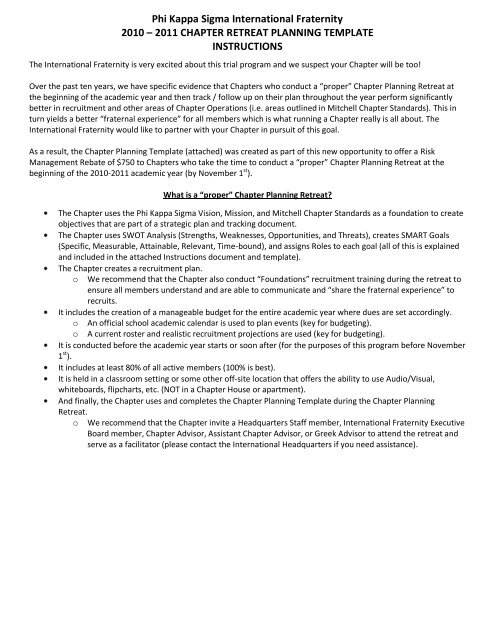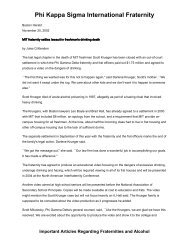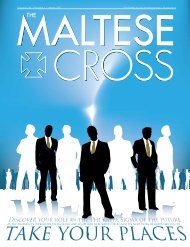Chapter Planning Retreat Template Instructions - Phi Kappa Sigma
Chapter Planning Retreat Template Instructions - Phi Kappa Sigma
Chapter Planning Retreat Template Instructions - Phi Kappa Sigma
Create successful ePaper yourself
Turn your PDF publications into a flip-book with our unique Google optimized e-Paper software.
<strong>Phi</strong> <strong>Kappa</strong> <strong>Sigma</strong> International Fraternity<br />
2010 – 2011 CHAPTER RETREAT PLANNING TEMPLATE<br />
INSTRUCTIONS<br />
The International Fraternity is very excited about this trial program and we suspect your <strong>Chapter</strong> will be too!<br />
Over the past ten years, we have specific evidence that <strong>Chapter</strong>s who conduct a “proper” <strong>Chapter</strong> <strong>Planning</strong> <strong>Retreat</strong> at<br />
the beginning of the academic year and then track / follow up on their plan throughout the year perform significantly<br />
better in recruitment and other areas of <strong>Chapter</strong> Operations (i.e. areas outlined in Mitchell <strong>Chapter</strong> Standards). This in<br />
turn yields a better “fraternal experience” for all members which is what running a <strong>Chapter</strong> really is all about. The<br />
International Fraternity would like to partner with your <strong>Chapter</strong> in pursuit of this goal.<br />
As a result, the <strong>Chapter</strong> <strong>Planning</strong> <strong>Template</strong> (attached) was created as part of this new opportunity to offer a Risk<br />
Management Rebate of $750 to <strong>Chapter</strong>s who take the time to conduct a “proper” <strong>Chapter</strong> <strong>Planning</strong> <strong>Retreat</strong> at the<br />
beginning of the 2010-2011 academic year (by November 1 st ).<br />
What is a “proper” <strong>Chapter</strong> <strong>Planning</strong> <strong>Retreat</strong>?<br />
The <strong>Chapter</strong> uses the <strong>Phi</strong> <strong>Kappa</strong> <strong>Sigma</strong> Vision, Mission, and Mitchell <strong>Chapter</strong> Standards as a foundation to create<br />
objectives that are part of a strategic plan and tracking document.<br />
The <strong>Chapter</strong> uses SWOT Analysis (Strengths, Weaknesses, Opportunities, and Threats), creates SMART Goals<br />
(Specific, Measurable, Attainable, Relevant, Time-bound), and assigns Roles to each goal (all of this is explained<br />
and included in the attached <strong>Instructions</strong> document and template).<br />
The <strong>Chapter</strong> creates a recruitment plan.<br />
o We recommend that the <strong>Chapter</strong> also conduct “Foundations” recruitment training during the retreat to<br />
ensure all members understand and are able to communicate and “share the fraternal experience” to<br />
recruits.<br />
It includes the creation of a manageable budget for the entire academic year where dues are set accordingly.<br />
o An official school academic calendar is used to plan events (key for budgeting).<br />
o A current roster and realistic recruitment projections are used (key for budgeting).<br />
It is conducted before the academic year starts or soon after (for the purposes of this program before November<br />
1 st ).<br />
It includes at least 80% of all active members (100% is best).<br />
It is held in a classroom setting or some other off-site location that offers the ability to use Audio/Visual,<br />
whiteboards, flipcharts, etc. (NOT in a <strong>Chapter</strong> House or apartment).<br />
And finally, the <strong>Chapter</strong> uses and completes the <strong>Chapter</strong> <strong>Planning</strong> <strong>Template</strong> during the <strong>Chapter</strong> <strong>Planning</strong><br />
<strong>Retreat</strong>.<br />
o We recommend that the <strong>Chapter</strong> invite a Headquarters Staff member, International Fraternity Executive<br />
Board member, <strong>Chapter</strong> Advisor, Assistant <strong>Chapter</strong> Advisor, or Greek Advisor to attend the retreat and<br />
serve as a facilitator (please contact the International Headquarters if you need assistance).
<strong>Phi</strong> <strong>Kappa</strong> <strong>Sigma</strong> International Fraternity<br />
2010 – 2011 CHAPTER RETREAT PLANNING TEMPLATE<br />
INSTRUCTIONS<br />
HOW TO USE THE CHAPTER RETREAT PLANNING TEMPLATE<br />
<strong>Chapter</strong> Information Worksheet<br />
1. Simply select your school name and fill in the membership numbers and other information as applicable.<br />
Strategic <strong>Planning</strong> and Tracking Worksheet<br />
1. Discuss the <strong>Phi</strong> <strong>Kappa</strong> <strong>Sigma</strong> Vision and Mission redefining each and putting action behind the points made.<br />
a. This will help all members better understand the purpose of our Fraternity. In addition, it will help you<br />
in the subsequent steps of coming up with objectives and goals for your <strong>Chapter</strong>.<br />
2. Come up with and add any objectives in addition to the 6 provided.<br />
3. Conduct a SWOT Analysis for the first objective listing Strengths, Weaknesses, Opportunities, and Threats for the<br />
objective in cells below each column header as applicable.<br />
a. Strengths and Weaknesses are INTERNAL factors that may affect an objective<br />
b. Opportunities and Threats are EXTERNAL factors that may affect an objective<br />
4. Create SMART Goals for the first objective in the cells below the column header as applicable.<br />
a. SMART Goals are Specific, Measurable, Attainable, Relevant, and Time-bound.<br />
i. All SMART Goals must be relevant to the vision, mission, and values (purpose and principles) of<br />
the Fraternity. Discontinue discussion of any goals that are not.<br />
5. Assign a member to “champion” each SMART Goal by putting their name next to the applicable SMART Goal<br />
under the “Roles” column.<br />
a. This person does not necessarily do ALL the work to accomplish the goal but is responsible for making<br />
sure it is accomplished.<br />
6. Determine the first step/action item to accomplish the goal and input it into the cell next to the applicable<br />
SMART Goal/Role under the “1 st Step” column.<br />
7. Repeat steps 3-6 for each objective until finished.<br />
8. We recommend that you use and update the spreadsheet on a weekly basis during the year to track progress<br />
a. Once a goal is complete make note of that in the appropriate week’s cell and confirm<br />
documentation/verification for Mitchell <strong>Chapter</strong> Standards purposes if applicable.<br />
b. Adjust or create new goals throughout the year using steps 4-6 above.<br />
Recruitment Names List Worksheet<br />
1. Add names (first and last) to the list by asking all members for names of unaffiliated males they have met/know<br />
on campus and doing mind-jogging and referral exercises (this can be found in “Foundations”).<br />
2. Fill in ALL of the additional information as applicable to each person on the Names List.<br />
a. Date – the date the name was added to the list<br />
b. Year – their year in school (e.g. Freshman, Sophomore, etc.)<br />
c. Cell Phone<br />
d. Email Address<br />
e. Champion – the person who met them or who is closest to them (they are responsible for inviting them<br />
out and following up with them)<br />
f. Current Funnel Step – Meet Him, Make Him a Friend, Introduce Him to Your Friends, Introduce Him to<br />
the Fraternity, Ask Him to Join<br />
g. Cumulative GPA – put in cumulative GPA and note HS or college as applicable (if they have a GPA from<br />
college you MUST use that)<br />
h. Involvement Notes – note what organizations they have been/are involved in<br />
i. “Man of Honor” Notes – note information related to their character and who their reference(s) is(are)<br />
j. Biddable – Mark Yes or No to note if you can proceed to the Funnel Step “Ask to Join.”<br />
i. You can only mark Yes and ask them to join once you have had a conversation to “Introduce<br />
Them to the Fraternity” and they have met all of your Values Based Selection Criteria (please<br />
see recommendations in number 4 below for more information)<br />
k. Accept – Mark NA (not applicable) Yes or No based on their bid status
<strong>Phi</strong> <strong>Kappa</strong> <strong>Sigma</strong> International Fraternity<br />
2010 – 2011 CHAPTER RETREAT PLANNING TEMPLATE<br />
INSTRUCTIONS<br />
l. Bid Date – Mark their bid date if they accepted<br />
m. Notes – note any other pertinent information as warranted<br />
3. We recommend that you update the Names List weekly (the Recruitment Chair is responsible for this)<br />
4. Additional recruitment recommendations:<br />
a. Use “Foundations” to conduct recruitment training prior to adding names the first time and coming up<br />
with your values based selection criteria.<br />
i. All members should be able to “share the experience” (and know what that means)<br />
1. Brotherhood and Networking – you develop lifelong friendships with guys that you can<br />
count on in any situation and gain a connection to thousands of alumni around the<br />
world.<br />
2. Self-Awareness – you learn about yourself – your interest, your personality, your<br />
leadership and teamwork styles, etc.<br />
3. Leadership Skills – you learn communication, conflict resolution, how to manage and<br />
motivate other people based on their personality, etc.<br />
4. Management Skills – you learn financial management, project management,<br />
time/resource management, how to conduct meetings, etc.<br />
5. Service – you give back to your community and make a difference in other people’s lives<br />
through participating in many community service and philanthropy events.<br />
6. Social Excellence – you have fun and learn how to interact responsibly and effectively<br />
with others in social settings.<br />
7. Academic Excellence – you learn from and with others in order to achieve your full<br />
academic potential.<br />
8. “Men of Honor” – above all, you do and learn all of this to better yourself and others in<br />
order to ultimately become a “Man of Honor.”<br />
ii. All members should know “Funnel Theory” and master basic social interaction skills (i.e. be able<br />
to introduce themselves to someone and have a conversation with that person for several<br />
minutes)<br />
1. Information and exercises can be found in “Foundations” and are STRONGLY<br />
recommended<br />
iii. Your <strong>Chapter</strong> should come up with Values Based Selection Criteria and all members should know<br />
what they are<br />
1. At a Minimum we suggest your Values Based Selection Criteria include the following:<br />
a. GPA – minimum 3.0 High School or 2.5 College<br />
b. Involvement – minimum 1 organization membership (High School or College)<br />
c. Character (“Man of Honor”) – minimum NO school or public record (no<br />
misdemeanor or felony convictions or school violations) and at least 1<br />
recommendation from a 3 rd Party (e.g. teacher, coach, pastor, school official,<br />
PKS Alumnus, etc.)<br />
Recruitment Plan Worksheet<br />
1. Complete the information for Fall 2010 under the Recruitment <strong>Planning</strong> and Information 2010-2011 section at<br />
the top of the worksheet<br />
a. Recruitment Chair Name<br />
b. Recruitment Chair Email<br />
c. New Member Goal for Term<br />
d. Number of Unaffiliated Males on Campus (obtain this number from your Greek Advisor)<br />
e. Number of Names on Names List<br />
f. Names List Last Update Date<br />
g. Recruitment Budget<br />
h. Recruitment Expenses to Date<br />
i. Date (latest date of recruitment expenses)<br />
2. Complete the information for Fall 2010 under the Event <strong>Planning</strong> and Evaluation Fall 2010 section
<strong>Phi</strong> <strong>Kappa</strong> <strong>Sigma</strong> International Fraternity<br />
2010 – 2011 CHAPTER RETREAT PLANNING TEMPLATE<br />
INSTRUCTIONS<br />
a. Event Date<br />
b. Event Description (ideas for events can be found in “Foundations”)<br />
c. Estimated Cost<br />
d. Estimated Attendance (non-members only)<br />
e. Number of Active Members (this should be the same as the number of members for Fall 2010<br />
3. Once your <strong>Chapter</strong> starts having events fill in the other information for Fall 2010 under the Event <strong>Planning</strong> and<br />
Evaluation Fall 2010 section as applicable<br />
a. Actual Cost (fill this in after each event)<br />
b. Actual Attendees (fill this in after each event)<br />
c. Number of Bids Extended (this should be added right before you start New Member Education)<br />
d. Total New Members (this should be added right before you start New Member Education)<br />
4. Evaluate recruitment budget, event, and overall recruitment performance and make adjustments as necessary<br />
prior to Spring 2011<br />
5. Repeat all steps above for Spring 2011<br />
Event <strong>Planning</strong> Worksheet<br />
1. Complete the information under the Social Event <strong>Planning</strong> 2010-2011 section at the top of the worksheet<br />
a. Event Date<br />
b. Event Type (e.g. Mixer, Social, Formal, Date Party, Alumni, Homecoming, etc.)<br />
c. Event Description (additional detail about what, where, etc.)<br />
d. Estimated Cost<br />
e. Actual Cost (fill this in after each event)<br />
f. Invitees (e.g. Name of Fraternity(s), Name of Sorority(s), Name of Organization(s), Alumni, Parents, etc.)<br />
g. Alcohol (Yes or No)<br />
h. Event <strong>Planning</strong> Form Completed (Yes or No)<br />
i. The Event <strong>Planning</strong> Form can be found at http://www.pks.org/resources.php and must be<br />
completed and submitted to the International Headquarters at least 30 days prior to any event<br />
with alcohol<br />
i. Date Sent to PKS HQ (the date the Event <strong>Planning</strong> Form was sent to PKS HQ)<br />
2. Complete the information under the Service Event <strong>Planning</strong> 2010-2011 section at the bottom of the worksheet<br />
a. Event Date<br />
b. Event Type (i.e. <strong>Phi</strong>lanthropy or Community Service)<br />
c. Event Description (additional detail about what, where, etc.)<br />
d. Estimated Cost (if applicable)<br />
e. Actual Cost (fill this in after each event if applicable)<br />
f. Estimated Dollars Raised<br />
g. Actual Dollars Raised (fill this in after each event if applicable)<br />
h. Estimated Number of Members Attending<br />
i. Actual Number of Members Attended (fill this in after each event if applicable)<br />
j. Estimated Service Hours / Member<br />
k. Actual Service Hours / Member<br />
l. Total Service Hours<br />
m. Name of Organization Benefited<br />
n. <strong>Phi</strong>lanthropy / Community Service Form Completed (Yes or No)<br />
i. The <strong>Phi</strong>lanthropy / Community Service Form can be found at http://www.pks.org/resources.php<br />
and must be sent to the International Headquarters to receive credit on Mitchell <strong>Chapter</strong><br />
Standards<br />
o. Date Sent to PKS HQ (the date the <strong>Phi</strong>lanthropy / Community Service Form was sent to PKS HQ)<br />
p. Documentation / Verification (Yes or No)<br />
i. This refers to copies of checks and/or signed letters on organization letterhead stating how<br />
much money the <strong>Chapter</strong> raised or how many service hours the <strong>Chapter</strong> performed. This
<strong>Phi</strong> <strong>Kappa</strong> <strong>Sigma</strong> International Fraternity<br />
2010 – 2011 CHAPTER RETREAT PLANNING TEMPLATE<br />
INSTRUCTIONS<br />
information must be sent to the International Headquarters to receive credit on Mitchell<br />
<strong>Chapter</strong> Standards.<br />
Budget Worksheet<br />
1. Complete the “actual” budget numbers for income and expenses as applicable to your <strong>Chapter</strong>.<br />
a. Much of the data for the “recommended” budget numbers will be filled in automatically based on the<br />
numbers you inputted on the <strong>Chapter</strong> Information Worksheet<br />
2. Use information from the recruitment plan worksheet, event planning worksheet, campus calendar, etc. to<br />
come up with the number and cost of recruitment events, social events, service events, and other expenses as<br />
applicable.<br />
ADDITIONAL INFORMATION AND ASSISTANCE<br />
Please contact the International Headquarters (610-469-3282 or staff@pks.org) if you have any questions or if we can be<br />
of assistance in any way. We look forward to helping you achieve your <strong>Chapter</strong>’s objectives and goals throughout the<br />
2010-2011 academic year!
Facilitation is making things easier and includes:<br />
<strong>Phi</strong> <strong>Kappa</strong> <strong>Sigma</strong> International Fraternity<br />
2010 – 2011 CHAPTER RETREAT PLANNING TEMPLATE<br />
INSTRUCTIONS<br />
FACILITATION BEST PRACTICES<br />
Supporting the curriculum through discussion and activities.<br />
Creating connections of shared information and experience<br />
Helping participants get good information and affirmation<br />
Providing focus and direction<br />
Appropriately challenging and questioning participants<br />
Effective facilitation requires facilitators that are:<br />
o Natural and genuine.<br />
o Interested in all participants.<br />
o Engaged in a series of conversations with a variety of participants.<br />
o Clear and non-judgmental in their communication.<br />
o Flexible and able to adapt to different situations.<br />
o Focused on the participant’s experiences and struggles.<br />
Ideas for Dealing with Common Group Situations<br />
Using Silence<br />
o Trust silence when it occurs. Often this is a signal that learning is occurring and you’ve identified a difficult<br />
conversation. Give participants time to form their thoughts.<br />
o Count to ten before asking another question or filling the void. When the silence becomes uncomfortable to<br />
the group, someone usually steps in and breaks the ice. Wait for it.<br />
Disruptive Group Members<br />
o Handling disruptive behaviors is often difficult. The key is to handle the disruption without hurting the<br />
individual and/or group.<br />
o Keep in mind that you are not alone and are bound to have allies in the group. Use these allies to bring the<br />
discussion back to a constructive place.<br />
o Private conversations outside of the group meeting might be necessary with the disruptive person.<br />
Dominating Conversation<br />
o Some participants might over-participate or dominate conversations. Use techniques to balance<br />
conversation or change how you ask questions to encourage others to participate as well.<br />
Negativity<br />
o If a participant(s) is relentlessly negative and skeptical, use techniques that involve participants in problem<br />
solving and identifying ways to be optimistic.<br />
o It is important that you don’t allow the group to fall prey to this negativity.<br />
o Give the complainer constructive feedback outside the group if the negativity impacts the group.<br />
Talking on the side<br />
o Side conversations can negatively impact the group. Facilitators can use several techniques including eyecontact<br />
with the smaller group, having the group move around to mix the group, involving the smaller group<br />
by asking them a direct question, and/or discussing the issue outside of the group during a break.






